
Pulp and paper making is energy intensive. A great deal of energy is required to separate solid wood into fibers. (Mills producing recycled paper products thus have lower energy requirements than virgin mills.) In addition, the process of making paper and paperboard requires that fibers be transported and distributed into a thin sheet using water. The water that cannot be squeezed from this sheet must be evaporated, which requires a substantial amount of energy.
Wood products plant energy requirements vary considerably by plant type. Plants processing wood products from logs must convert the logs to boards, wafers, chips or fibers, and then dry the wood. Converting and drying are both energy intensive. Additional energy is required to process the wood into lumber or panels.
For more information, use the grid below. Hover over the bubbles to see possible effects of decreasing energy consumption. How
should I use this information?
If you are unable to view the video here, you can also find all the videos in this site here.

 Energy consumption in the North American forest products industry has declined over the years, while the fraction of energy supplied by renewable fuels has increased.
Energy consumption in the North American forest products industry has declined over the years, while the fraction of energy supplied by renewable fuels has increased.
 Mills usually generate electricity in efficient combined heat and
Mills usually generate electricity in efficient combined heat and
power (CHP) systems. Sometimes the amount of electricity generated by a mill exceeds its needs, and the mill can sell electricity to the "grid."
 The industry obtains much of its energy from renewable sources, particularly biomass (mostly parts of the tree not needed for paper and paperboard production).
The industry obtains much of its energy from renewable sources, particularly biomass (mostly parts of the tree not needed for paper and paperboard production).


